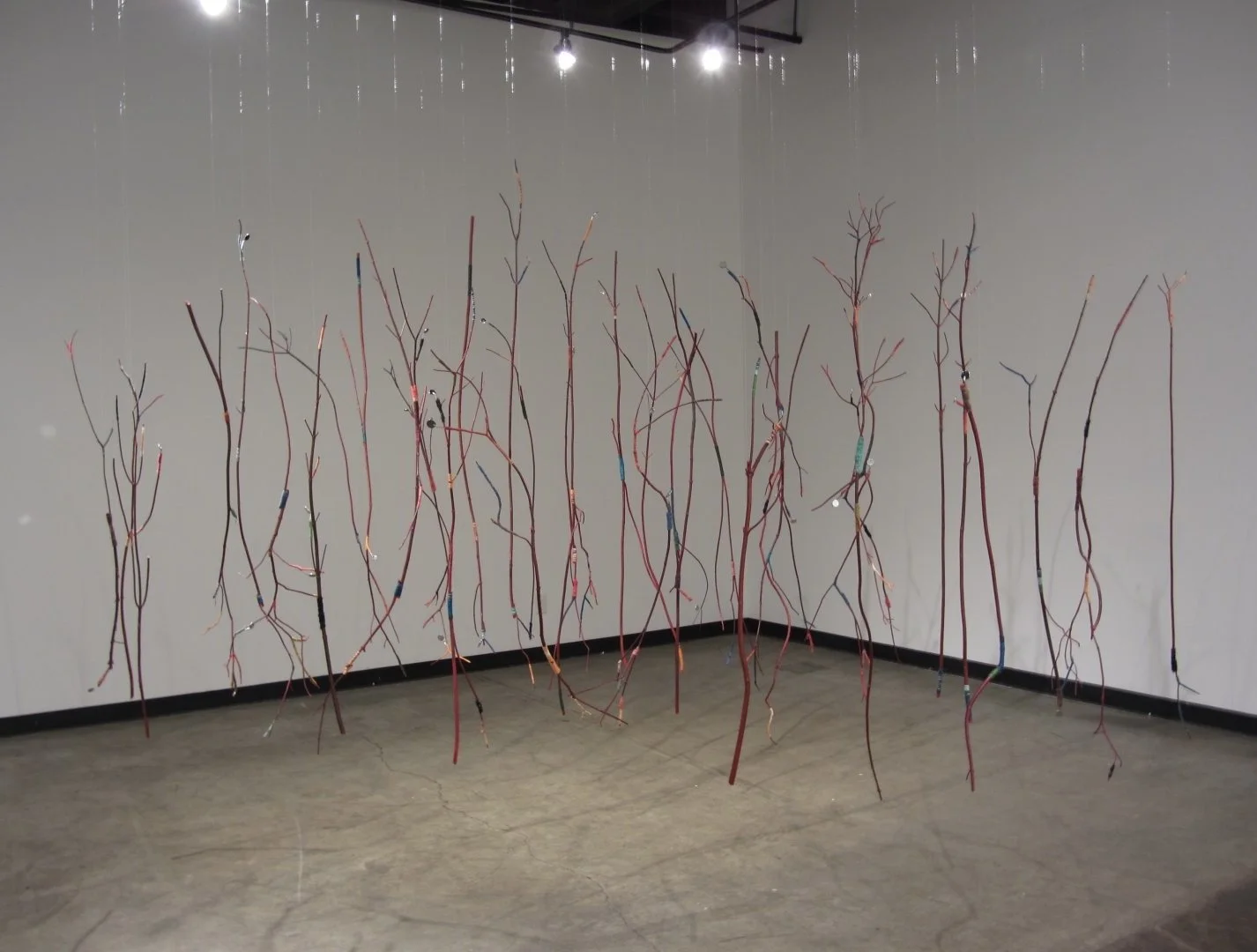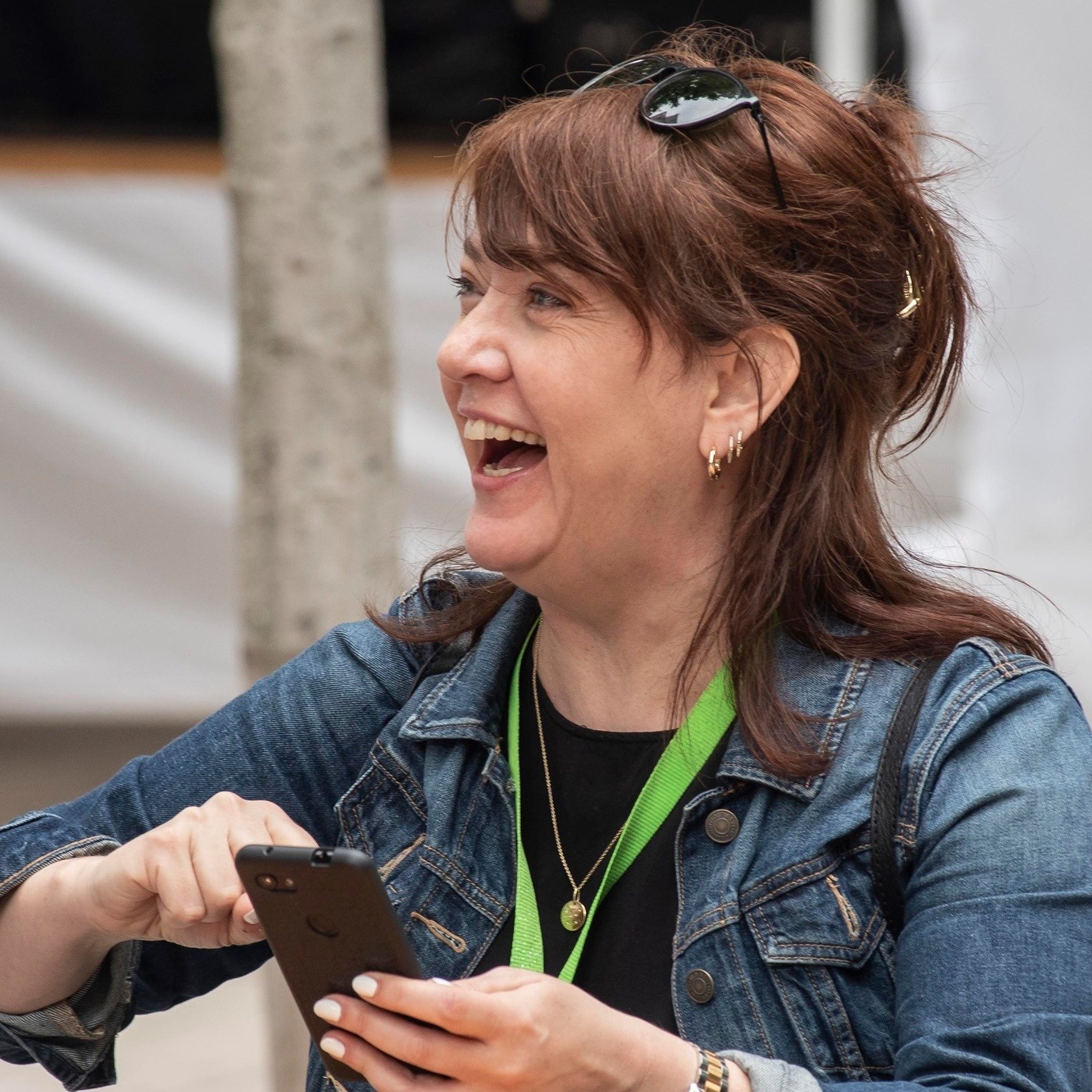Stir Q&A: Duo behind VAG Offsite's Pedestrian Protest talk stopping traffic, Georgia Street, and tap-dancing on train tracks
Artists Evann Siebens and Keith Doyle reflect on a mammoth project that involved 50 artists during a pandemic shoot
Evann Siebens and Keith Doyle’s Pedestrian Protest, a site-specific installation at Vancouver Art Gallery Offsite to October 11. Photo by Ian Lefebvre, Vancouver Art Gallery
VANCOUVER ARTISTS Evann Siebens and Keith Doyle collaborated with nearly 50 local artists and activists for the new Vancouver Art Gallery Offsite installation Pedestrian Protest.
Easily viewable outdoors at 1100 West Georgia Street between Thurlow and Bute streets until October 11, it incorporates audio, imagery, and sculpture into a multimedia installation that will open your mind to the history of protests along Georgia Street through the years. Siebens filmed their performances—more than 24 in all—combining them into a collage of media and movement that maps our changing city.
Doyle is an associate professor in the Faculty of Design + Dynamic Media and the Faculty of Graduate Studies at Emily Carr University who is also a sculptor and codirector of Material Matters, the material research centre at ECU that focuses on design-led research partnerships. Siebens was a dancer with the National Ballet of Canada and the Bonn Ballett in Germany before studying film production at New York University, and turning her lens-based practice to the human body and the politics of the female gaze.
We asked them a few questions about Pedestrian Protest, which has its own website here.
You collaborated with more than 50 local artists and activists on 24 media performances on various sites for this work—all during a pandemic. What were the biggest challenges, and is there a day or performance that stands out in your mind as a feat?
“We’ve been working on this project for almost three years now, and we did not consider how a pandemic would alter and change absolutely everything! Our original idea, of gathering and filming in large groups, had to be changed and so this concept of doing multiple, individual, socially distant film shoots emerged. In many ways, it turned out to have such a positive effect, as it felt safe to the participants, but also extremely intimate, personal and emotional. To be out filming in the rain in November and January (the pandemic also moved our shooting schedule from the summer to the wet, dreary winter) but to connect with another human, to be making art felt like a real privilege. I think it added to the vibrancy and feeling in the media and the photographs and made the work stronger in the end.
“There were many days when it felt like a feat to be out in the world and filming! I keep thinking about shooting Margaret Dragu, who is an internationally renowned performance artist who has been working as a professional artist for 50 years now. We were shooting on the train tracks down by La Casa Gelato’s Pink Wall on Venables. Margaret had wanted to tap dance down the train tracks with her mobility sticks. (In Margaret’s bio is the following phrase: ‘Her favourite material is still the body despite/because of her bionic status as the grateful owner of two hip replacements.’) We were just doing our thing, tap dancing and filming on the tracks, when we heard the unmistakable sound of a train approaching. ‘Keep dancing!’ I yelled to Margaret. And as a consummate pro, she tap-danced the entire time that train went by. It was spectacular, and such an epic performative moment. Afterwards we got the giggles and wondered what the train conductor thought we were doing.
“There was also a lot of stopping traffic. I loved shooting the section with Paul Wong and his ‘Pride in Chinatown Team.’ We were out on the streets with our banner and Paul was directing the members of the collective, Kara Juku, Tien Neo Eamas ,and Natasha Neale, as they marched down the street. There was no Chinese New Year parade this year, but Paul and his team created their own parade!
“We also stopped traffic with the collective Butterflies in Spirit, who chose Granville and Georgia as their site. Founded in 2012 by Lorelei Williams, Butterflies in Spirit is a dance group consisting of family members of missing and murdered Indigenous women and girls (MMIWG). We were introduced to Lorelei and her group by Vines Art Festival, the annual festival held in August that supports artists working towards relational justice. The Butterflies were wonderful to work with, and they had previously created a performance on this site where they shut down the intersection and danced in protest, so this was a reference to their own history. I loved how they walked and moved in tandem across the streets, stopping traffic and garnering admiring looks. But I also appreciated how when they were in the middle of the intersection at Georgia, someone called out from their car, ‘Hey Lorelie, how are you?!’ It felt so important and far-reaching and yet personal and local, in the best sense, at the same time.”
What did you discover in your research on Georgia Street's history and how did that drive the project?
“We actually started our initial research for the project with the idea of mapping the street, and had looked at Stan Douglas’s 2002 work Every Building on 100 East Hastings and also Ed Ruscha’s 1966 artist book Every Building on the Sunset Strip. We were interested in this idea of conceptually mapping the city and using site as way to interrogate histories of protest and the changing city. We thought Georgia Street was particularly interesting as a metaphor of Vancouver, beginning at Boundary Road and moving past the Vancouver Specials of East Van through Strathcona and into Chinatown. Then jumping up onto the Georgia Viaduct with its fraught history, where Georgia Street becomes a major artery for the city with its public buildings (and where many protests have occurred): the Queen Elizabeth Theatre, the CBC Building, the Vancouver Art Gallery, and on to where Offsite is located, across from the Trump Tower. It then extends into Stanley Park and perhaps you could even think of it as ending in the middle of the Lion’s Gate Bridge.
“One of the requests to the collaborating artists that we worked with was to ‘choose a site along Georgia Street.’ Many artists chose sites that had meaning to them, either a site that they had attended or led protests in the past, but also that they wanted to bring attention to. Of course many artists chose sites that were off Georgia and that become interesting too. For example, the Man Up Collective chose ‘Little Sisters’ as their site (on Davie Street), as they wanted to bring attention to this iconic bookstore that won an important battle in the Supreme Court for decensorship and queer liberation in the 1990s.
“So we moved away from mapping Georgia Street, because we followed the lead of our collaborating artists! But this quilt or choir of individual voices and creative ideas and locations made the project so much more interesting, and also really highlighted the many creative voices we have here in the city."
Butterflies in Spirit, in a still from the video for Pedestrian Protest. Courtesy of the artist
Once you had all the visual and auditory materials, how did you go about designing and integrating them into the Offsite space?
“Offsite is a very challenging site as it needs to work on two levels: it’s a pedestrian site that people walk through and live close to, but it’s also a ‘drive-by’ site where many people experience it from a moving vehicle. So we tried to integrate both of those into the installation. Keith created the sculptural elements that draw you into the space and created a three-dimensional experience, with the analogies to construction materials and the ever-changing city (that has become part of Vancouver’s architecture), while the banners create this feeling of being surrounded by people and histories, and perhaps even evoke the feeling of being at a crowded protest. This is exemplified by the Pedestrian Protest Parade, the mural of people that are on the walls, that in many ways is a mapping of many of Vancouver’s artists at this moment in history. And yet the media on the LED screen slows things down and invites you to stay for a while, to come and watch.
“This is the challenge of durational artwork such as media and performance, and exemplified in the public space: How do you ask people to come and spend time in their busy day? The film is actually one hour and 45 minutes long, but was designed with the expectation that an individual wouldn’t spend longer than three to five minutes in the space. And yet this means that each time they visit, that they will experience a different installation. One of my favourite comments from a colleague so far was, ‘I watched someone in their car stay at a green light, holding up traffic for over a minute because they were so engaged in the installation.’ Now that’s what I call success!”
Margaret Dragu, Sophia Wolfe, and xomaleon Phîlp babur in stills from the video for Pedestrian Protest at the VAG Offsite. Courtesy of the Artist
Part of your activism has surrounded performers' rights and participants were all compensated here. Was part of the motivation to support artists at a time when they've been hit hard financially or was that just a happy byproduct?
“We felt very strongly about supporting our fellow artists in this difficult moment in history—not only financially and through our sharing of the media with the individual artists, and the care taken to make sure that each artist was credited properly. I always think it’s interesting that the photographer of an image is often very diligently credited, but rarely the performer or the person depicted, so we’ve been trying very hard to create a different model for that.
“But also the simple fact of making some sort of art over the last year was very affecting for us, also for all the people that we worked with. This is particularly true for artists who work in live performance and the performing arts, as so many of their shows were ‘COVID cancelled’ this last year. We knew we always wanted to bring attention to the many amazing dancers, visual artists, activists and performers that are in Vancouver. So to have an opportunity to support them in a gig that wasn’t cancelled, that was outdoors and free to the public was even better!”
Performance and protest have been hard to do with social distancing measure this year. What has the project taught you about the importance and relationship between the two?
"The physical body is at the core of so many activities in our culture, whether it be artwork or gathering or protest, or simply spending time with another human being. I believe this project, and the pandemic for so many, has made us appreciate our human connections."
















